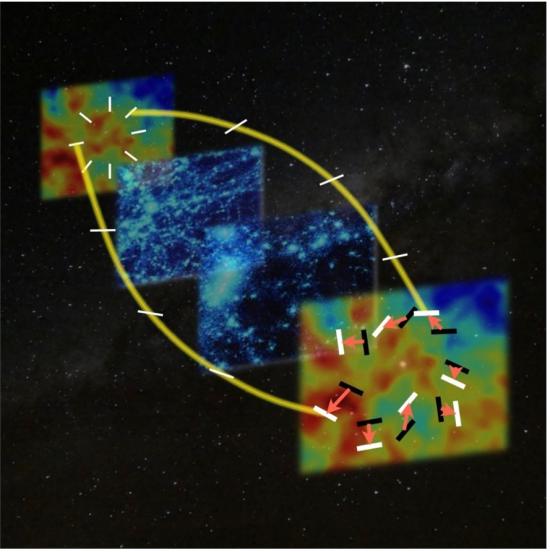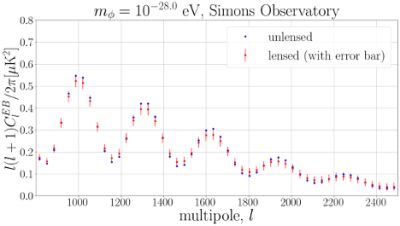November 2, 2023
Kavli Institute for the Physics and Mathematics of the Universe (WPI-Kavli IPMU)

(Credit: Naokawa and Namikawa, https://doi.org/10.1103/PhysRevD.108.063525)
Future missions will be able to find signatures of violating the parity-symmetry in the cosmic microwave background polarization more accurately after a pair of researchers has managed to take into account the gravitational lensing effect, reports a new study in Physical Review D, selected as an Editors' Suggestion.
How far does the universe extend? When and how did the universe begin? Cosmology has made progress in addressing these questions by providing observational evidence for theoretical models of the universe based on fundamental physics. The Standard Model of Cosmology is widely accepted by researchers today. However, it still cannot explain fundamental questions in cosmology, including dark matter and dark energy.
In 2020, an interesting new phenomenon called cosmic birefringence was reported from the cosmic microwave background (CMB) polarization data. Polarization describes light waves oscillating perpendicularly to the direction it is traveling. In general, the direction of polarization plane remains constant, but can be rotated under special circumstances. A reanalysis of the CMB data showed the polarization plane of the CMB light may have slightly rotated between the time it was emitted in the early universe and today. This phenomenon violates the parity symmetry and is called the cosmic birefringence.
Because cosmic birefringence is challenging to explain with the well-known physical laws, there is a strong possibility that yet to be discovered physics, such as the axionlike particles (ALPs), lies behind it. A discovery of cosmic birefringence could lead the way to revealing the nature of dark matter and dark energy, and so future missions are focused on making more precise observations of the CMB.
To do this, it is important to improve the accuracy of current theoretical calculations, but these calculations so far have not been sufficiently accurate because they do not take gravitational lensing into account.
A new study by a pair of researchers, led by The University of Tokyo Department of Physics and Research Center for Early Universe doctoral student Fumihiro Naokawa, and Center for Data-Driven Discovery and Kavli Institute for the Physics and Mathematics of the Universe (Kavli IPMU) Project Assistant Professor Toshiya Namikawa, established a theoretical calculation of cosmic birefringence that incorporates gravitational lensing effects, and worked on the development of a numerical code for cosmic birefringence that includes gravitational lensing effects, which will be indispensable for future analyses.
First, Naokawa and Namikawa derived an analytical equation describing how the gravitational lensing effect changes the cosmic birefringence signal. Based on the equation, the researchers implemented a new program to an existing code to compute the gravitational lensing correction, and then looked at the difference in signals with and without the gravitational lensing correction.
As a result, the researchers found that if gravitational lensing is ignored, the observed cosmic birefringence signal cannot be fitted well by the theoretical prediction, which would statistically reject the true theory.
In addition, the pair created simulated observational data that will be obtained in future observations to see the effect of gravitational lensing in the search for ALPs. They found that if the gravitational lensing effect is not considered, there would be statistically significant systematic biases in the model parameters of ALPs estimated from the observed data, which would not accurately reflect the ALPs model.
The gravitational lensing correction tool developed in this study is already being used in observational studies today, and Naokawa and Namikawa will continue to use it to analyze data for future missions.
Details of their study were published in Physical Review D on September 27 as an Editors’ Suggestion.


F. Naokawa & T. Namikawa “Gravitational lensing effect on cosmic birefringence”, Phys. Rev. D 108, 063525, Copyright (2023) the American Physical Society
https://doi.org/10.1103/PhysRevD.108.063525
Paper details
Journal: Physical Review D
Paper title: Gravitational lensing effect on cosmic birefringence
Authors: Fumihiro Naokawa (1,2) and Toshiya Namikawa (3,4)
Author affiliations:
1. Department of Physics, Graduate School of Science, The University of Tokyo, Bunkyo-ku, Tokyo 113-0033, Japan
2. Research Center for the Early Universe, The University of Tokyo, Bunkyo-ku, Tokyo 113-0033, Japan
3. Kavli Institute for the Physics and Mathematics of the Universe (Kavli IPMU, WPI), The University of Tokyo, Chiba 277-8583, Japan
4. Center for Data-Driven Discovery, Kavli IPMU (WPI), UTIAS, The University of Tokyo, Kashiwa, 277-8583, Japan
DOI: https://doi.org/10.1103/PhysRevD.108.063525
Paper abstract (Physical Review D)
Pre-print (arXiv.org)
Media enquiries
Research contact
Toshiya Namikawa
Project Assistant Professor
Kavli Institute for the Physics and Mathematics of the Universe
University of Tokyo
E-mail: toshiya.namikawa_at_ipmu.jp
* Please change _at_ to @
Fumihiro Naokawa
Doctorate student
Department of Physics, The University of Tokyo
Research Center for the Early Universe
E-mail: fumihiro.naokawa_at_resceu.s.u-tokyo.ac.jp
* Please change _at_ to @
Media contact
Motoko Kakubayashi
Press officer
Kavli Institute for the Physics and Mathematics of the Universe (Kavli IPMU)
The University of Tokyo
TEL: 04-7136-5980
E-mail:press_at_ipmu.jp
* Please change _at_ to @






